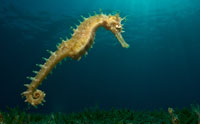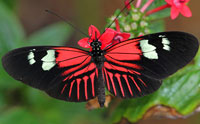Just when we thought we knew all the basics about the human body, anatomists made three surprising discoveries in 2016. The newfound human body complexity borders on science fiction. More… …read more Read more here: icr.org
Seminar by Chris Ashcraft Apologetics Symposium Cedar Park Church, Bothell WA January 6th, 2016 Description: What would the Earth be like without animals? They are indeed a very special part of the creation that provides endless fascination and brings much love into our lives. Previously unknown animals are discovered each year and the complicated world of these creatures has been made clearer by recent scientific discoveries. This presentation will focus on the amazing abilities of animals that are often a source of inspiration to engineers. Humans have long practiced biomimicry in an attempt to glean the ingenuity behind biological designs, [More]
“The more we document the marvels of design in ourselves and nature in general the more absurd the idea becomes this was all a product of chance. No one would dare think that the TV we watch or the computer we use arose by chance but there are those who think the human eye, far more complicated in design, was a product of random chance mistakes and mutations over millions of years … ridiculous. This quote from George Orwell is apropos for those teaching such nonsense: “Some things are so foolish that only an intellectual could believe them, for [More]
“The incredible process of metamorphosis, changing a caterpillar to the beautiful monarch, is astounding in it’s complexity and defies any evolutionary explanation. It is one of the most powerful arguments for creation I know of.” Admin A monarch’s development from caterpillar to adult and its incredible ability to migrate clearly display the Creator’s design. What animal has a brain the size of a pinhead and yet can pinpoint a location 3,000 miles (4828 km) away and navigate there with an accuracy of 100 feet (30.5 m)?1 It is the most famous butterfly in North America—the monarch. But the winged adult [More]
“I’ve posted a number of these articles about marvels of design which occur throughout nature yet no matter how many examples are given evolutionists still insist they are just products of blind random chance … how foolish can you get.” Admin For decades, human design engineers have been laboring to make more efficient machines, like propeller blades that produce steady airflow patterns. Our thinking has been fixed on the idea that smooth surfaces are the best basic form, but studies on whales and dolphins are changing that. A whale flipper has a bumpy edge. After incorporating some bumpy, irregular features into [More]
“Excellent article. How anyone could think that such a super sophisticated visual system could be the product of random chance is beyond me, since its complexity fairly shouts that it had to have been designed. If you would like to see more marvels of design watch the video God Of Wonders Here” Admin The fine nanorod structure of the mantis shrimp eyes allow it to rotate the polarization across the spectrum. This could help DVD players to process much more information. …read more Read more here: creation.com
“One of many marvels of design in nature.” Admin Unscrambling the mysteries by David Catchpoole Imagine a container filled with amorphous-looking bits of metal, plastic and some software chips. Could you imagine it breaking out as a fully-assembled scale model motor car? Then growing larger as it absorbs raw materials, as well as energy, from its surroundings? What sort of advanced software engineering would be required? As for any ideas of it being able to ‘marry’ another like itself, thus repeating the whole cycle by producing another container of metal, plastic and software … such notions could rightly be dismissed [More]
“More marvels of design that we are supposed to believe were the product of random chance processes … yeah, right.” Admin Scuba divers can explore underwater depths firsthand because of specialized equipment that was developed in just the last century. Likewise, solar-powered airplanes currently in development promise to provide fuel-free flying. These inventions open new realms for human exploration, but the arachnid and insect equivalents of their equipment have been on the planet for ages. Scuba is a stand-alone word today, but it began as the acronym for “self-contained underwater breathing apparatus,” so named because it supplies breathable air underwater. [More]
Science and the Bible agree. ICR zoologist and Research Associate Frank Sherwin tells us how in this 5-part podcast series on the scientific evidence for creation. From submicroscopic machines to the mighty oceans, Frank explores the marvels of design, buried clues from the past, and the myth of human evolution. More… …read more Read more here: icr.org
“Just one more of many marvels of design in nature that are proving extremely problematic for evolutionists.” Admin An international team of researchers has concluded an in-depth genetic analysis of the octopus, and some say their just-released findings present deep problems for the theory of evolution. The octopus has long been recognized as one of Earth’s most unusual creatures. Its intelligence, dexterity, and complexity are unparalleled among invertebrates. And, until last year, scientists had never fully mapped the genome of the octopus, so the eight-armed creature’s full genetic code remained a mystery. Finally, in a journal article published in Nature [More]
“Another excellent article highlighting how scientists with all their ingenuity can only create inferior copies of the marvels of design in nature and yet expect the public to swallow the absurd explanation that these natural marvels of design were somehow magically produced by blind random chance processes with no intelligence involved … how stupid can you get. ” Admin We know how man-made designs originate— people design them. But what about living designs? Two recent biomimicry research programs let slip the same logic errors when accounting for the origin of the creatures they copy: the seahorse and kangaroo. More… …read [More]
“Once again man is copying one of the marvels of design in Gods creation.” Admin Harvard’s Wyss Institute specializes in designing new materials and devices that mimic patterns found in living things. Their latest contribution was inspired by the versatile material found in insect cuticle, which is strong and flexible, yet remarkably lightweight. The result was “shrilk,” a moldable, biodegradable substance derived from shrimp shells and silk that is as strong as some aluminum alloys but only half their weight. “Shrilk could be used to make trash bags, packaging, and diapers that degrade quickly,” according to a Wyss Institute press [More]
“The honeybee’s guidance system and waggle dance it does to communicate to other bees how to get to the nectar are complex marvels of design. Another testimony to God’s handiwork.” Admin Polarized light imprints GPS directions on the honeybee brain’s genes. The uncanny ability of honeybees to remember and communicate the location of sweet nectar has been the subject of ongoing investigations—both navigational and genetic. “The more we find out how honeybees make their way around the landscape, the more awed we feel at the elegant way they solve very complicated problems of navigation that would floor most people—and then [More]
“More marvels of design in nature. How anyone could think such sophistication in design could happen by chance is beyond me. It almost shouts it was a product of intelligence and one far beyond ours.” Admin Many clams glue themselves onto a solid surface like a rock or coral reef to keep from being tossed about by the surf. The “glue” sets when wet and is extremely strong, partly because tiny fibers enable the glue to self-heal. Similarly, scientists have discovered that a form of bacteria produces an amazingly water-repellent substance called biofilm that “greatly surpass[es] the repellency of Teflon.”1 [More]
“The more one reads about such marvels of design through out nature the more absurd the idea becomes that they arose by chance.” Admin Trilobites, described by Stephen Jay Gould as ‘everyone’s favourite invertebrate fossil,’ are a class of marine arthropods which are often well preserved and of striking appearance.1,2They are believed to be extinct. They are mostly between 10 and 50 mm long (3/8 to two inches) although a few species attained a length of 750 mm (2 1/2 feet). Trilobites are characterized by a ridged carapace, or shell, made of chitin, divided into three lobes which give the [More]
“There are many marvels of designs like this through out nature and evolutionists want us to believe they all happened by chance … give me a break!” Admin Butterfly wings are covered with tiny scales that are marvelously efficient at shedding water—so much so that they are inspiring designers interested in developing water-resistant materials. More… …read more Read more here: icr.org
“Just one more of many marvels of design in nature.” Admin The humble fly hovering over a garbage can is routinely capable of some high-speed aeronautic manoeuvres that have long boggled the minds of aircraft designers and engineers. If a male fly chasing a potential mate sees her change course ever so slightly, he will respond with an appropriate change of his own in just 30 milliseconds! It has long been known that the amazing stability of flies as they zip around has a lot to do with the two tiny club-shaped ‘balancing organs’ they have, called halteres (see Figure [More]
By Douglas Axe On this episode of ID the Future from the vault, we hear from two contributors to the Crossway anthology, Theistic Evolution: A Scientific, Philosophical, and Theological Critique, Molecular biologist Douglas Axe and philosopher of science Stephen Meyer explain how Carbon Valley Trumps Silicon Valley, and shouts intelligent design. They compare some of today’s technological marvels to living technology, and show how even “simple cells” far exceed even the best silicon valley has to offer. Your browser does not support playing Audio, please upgrade your browser or find our podcast on podOmatic Download Episode …read more Source: id [More]
By Sarah Chaffee On this episode of ID the Future, we hear from two contributors to the new Crossway anthology, Theistic Evolution: A Scientific, Philosophical, and Theological Critique, Molecular biologist Douglas Axe and philosopher of science Stephen Meyer explain how Carbon Valley Trumps Silicon Valley, and shouts intelligent design. They compare some of today’s technological marvels to living technology, and show how even “simple cells” far exceed even the best silicon valley has to offer. Your browser does not support playing Audio, please upgrade your browser or find our podcast on podOmatic Download Episode …read more Source: id the future [More]
By jwitt Click here to listen to part 1 On this episode of ID the Future, Ray Bohlin and Jonathan Wells explore what it would take to build a functional whale from a land mammal, and the bear of a problem Darwin faced. The problem, it turns out, has only grown worse the more we learn about the marvels of whale anatomy. Your browser does not support playing Audio, please upgrade your browser or find our podcast on podOmatic Download Episode …read more Read more here: id the future
By Ken Ham This latest issue is packed full of informative articles that will fascinate you as they equip you to defend your faith. You’ll be intrigued by the flying reptiles known as pterosaurs; were they primitive, clumsy beasts, barely able to get off the ground, or were they intricately designed marvels perfect for the environment God put them in? In another intriguing article, we point out many people haven’t thought much about what the creatures on the Ark might have looked like. They just imagine today’s animals beside Noah and his family. Well, you might be surprised to learn [More]
By Creation Moments People sometimes wonder why, with all the marvels science can design and build, it cannot build a good replacement for the heart. As medical science learns more about the heart, it becomes clear that replacing this complex mass of muscles is more difficult than might be imagined. read more …read more Read more here: Creation Moments
“His talk starts at 1:50 but there is an audio problem that goes to 2:50 then it’s OK after that.” Admin Apologetics Forum of Snohomish County Streamed live on Sep 28, 2018 Flight in Birds. We look at the aerodynamics of birds, and show the awe and wonder from the fascinating detail of flight in the natural world. The feathers of birds have to be positioned in exactly the right location on the wing from front to back and from close to the body to tip, but also edge on forming an aerofoil shape. The remarkable agility of both fast [More]


























![Scientific Evidence for Creation [Podcast] Scientific Evidence for Creation [Podcast]](http://proofthebibleistrue.com/wp-content/uploads/2016/06/60389-thumb-200x124.jpg)




